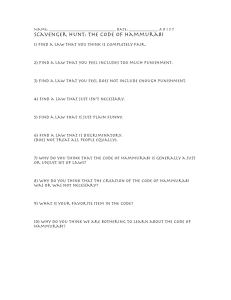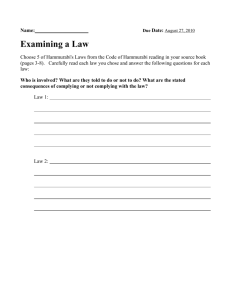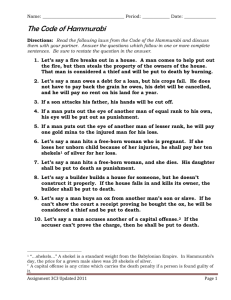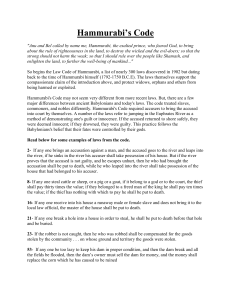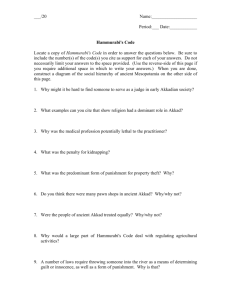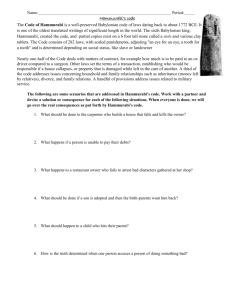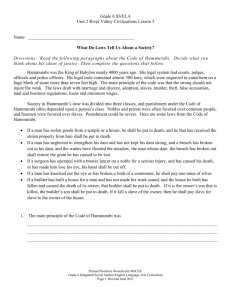TEACHING AID Answers to the discussion questions, and a grading
advertisement
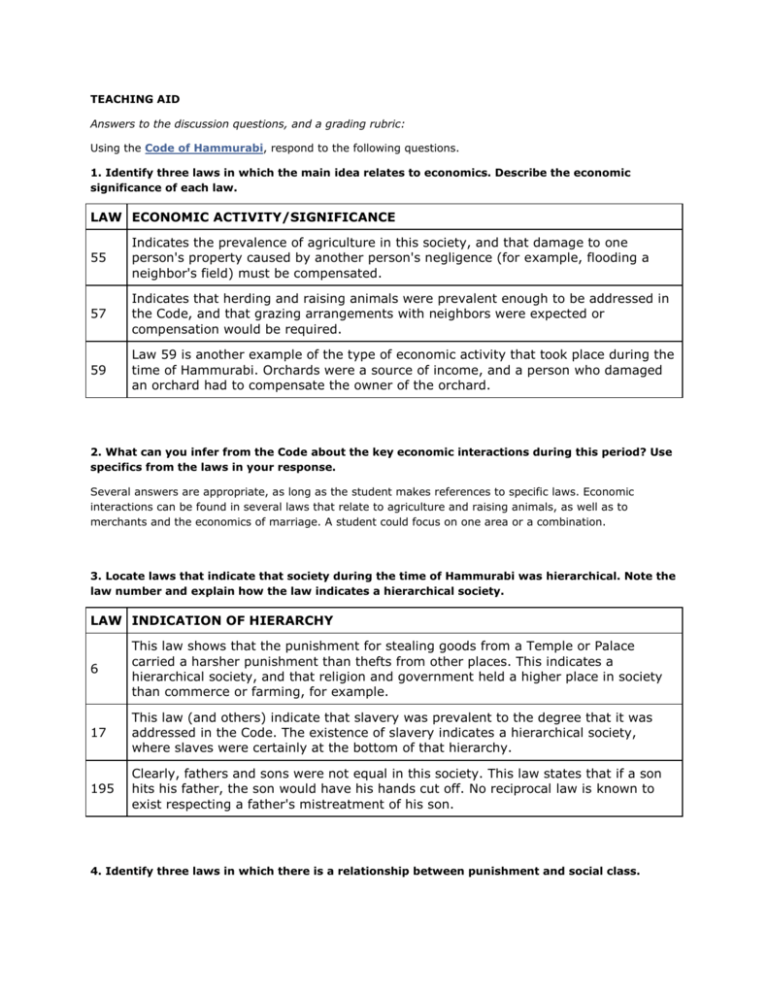
TEACHING AID Answers to the discussion questions, and a grading rubric: Using the Code of Hammurabi, respond to the following questions. 1. Identify three laws in which the main idea relates to economics. Describe the economic significance of each law. LAW ECONOMIC ACTIVITY/SIGNIFICANCE 55 Indicates the prevalence of agriculture in this society, and that damage to one person's property caused by another person's negligence (for example, flooding a neighbor's field) must be compensated. 57 Indicates that herding and raising animals were prevalent enough to be addressed in the Code, and that grazing arrangements with neighbors were expected or compensation would be required. 59 Law 59 is another example of the type of economic activity that took place during the time of Hammurabi. Orchards were a source of income, and a person who damaged an orchard had to compensate the owner of the orchard. 2. What can you infer from the Code about the key economic interactions during this period? Use specifics from the laws in your response. Several answers are appropriate, as long as the student makes references to specific laws. Economic interactions can be found in several laws that relate to agriculture and raising animals, as well as to merchants and the economics of marriage. A student could focus on one area or a combination. 3. Locate laws that indicate that society during the time of Hammurabi was hierarchical. Note the law number and explain how the law indicates a hierarchical society. LAW INDICATION OF HIERARCHY 6 This law shows that the punishment for stealing goods from a Temple or Palace carried a harsher punishment than thefts from other places. This indicates a hierarchical society, and that religion and government held a higher place in society than commerce or farming, for example. 17 This law (and others) indicate that slavery was prevalent to the degree that it was addressed in the Code. The existence of slavery indicates a hierarchical society, where slaves were certainly at the bottom of that hierarchy. 195 Clearly, fathers and sons were not equal in this society. This law states that if a son hits his father, the son would have his hands cut off. No reciprocal law is known to exist respecting a father's mistreatment of his son. 4. Identify three laws in which there is a relationship between punishment and social class. LAW PUNISHMENT-SOCIAL CLASS CONNECTION These two laws provide different punishments for the same action. Physical harm 198/199 done to a freed man is punished with a higher fine than for physical harm done to a slave. If a slave strikes a freed man, the slave will have his ear cut off. The punishment for the slave is greater than the punishment of a freed man for the same offense. Other laws indicate that the worst that could happen to a freed man who hit a slave is a monetary fine paid to the owner of the slave. 205 5. Identify three laws influenced by gender. Suggest how the consequences were affected by gender. LAW INFLUENCE OF GENDER 142/143 These laws put the burden of proof on the wife, and there are no reciprocal laws for husbands. 175 This law states that women alone are punished for not producing children in a marriage. 6. Select four laws (not previously addressed) and translate them into language that could easily be understood in today's society. LAW TRANSLATION 127 If you make false claims, you will be punished. 7. Identify any patterns as you read the laws in the Code. What conclusions can be drawn from these patterns? Answers will vary, but should indicate an understanding of patterns in the Law by grouping related laws and drawing conclusions based on the evidence. For example, a student could infer that the laws address issues that are most common during this era. Additionally, students could include topics that repeatedly or often surface in the Code; for example, issues related to marriage, dowry, inheritance, slaves, violence, and agriculture. 8. Suggest problems with the Code of Hammurabi. Answers will vary, but should address that many of the punishments could not be reversed and might be too easily meted out. Additionally, students should discuss the difference in punishment based on social class and gender. 9. In 8 to 10 sentences, respond to the following question: Relate the Code of Hammurabi to today's society and hypothesize if this type of system of laws could be effective or not effective. Answers will vary, but should include the effectiveness of punishment as a deterrent, the role of juries, ability to appeal court decisions, and the tolerance of discriminatory laws. Advanced Proficient Progressing Beginning Quality of Written Response Responses are thorough and thoughtful and have no grammatical errors. Responses are thorough and thoughtful but have some grammatical errors. Responses are perfunctory, and there are many grammatical errors. Incomplete responses with many grammatical errors. Analysis of Document Documents are analyzed in an insightful and complex manner. Analysis reveals little insight. There are no signs of thoughtful analysis of documents in responses. Use of Historical Context Prior historical Prior historical Little historical knowledge is used knowledge is used knowledge is used effectively to in the analysis. in responses. develop analysis. Analysis of documents shows some insight. How to cite this document: To cite this document, World Book recommends the following format: Code of Hammurabi. World Book Advanced. Web. 22 June 2012. No prior historical knowledge is used in responses.
